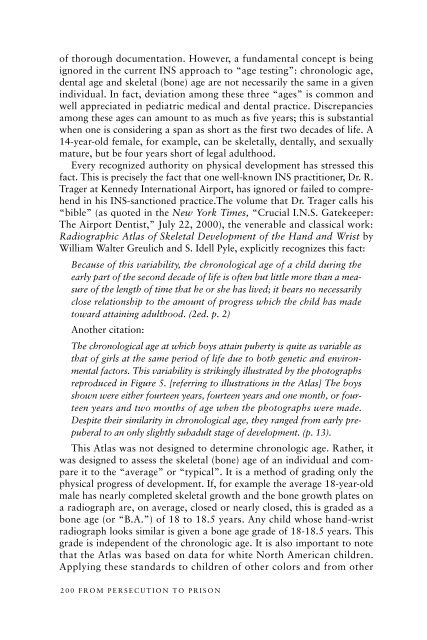From Persecution to Prison - Bellevue/NYU Program for Survivors of ...
From Persecution to Prison - Bellevue/NYU Program for Survivors of ...
From Persecution to Prison - Bellevue/NYU Program for Survivors of ...
Create successful ePaper yourself
Turn your PDF publications into a flip-book with our unique Google optimized e-Paper software.
<strong>of</strong> thorough documentation. However, a fundamental concept is beingignored in the current INS approach <strong>to</strong> “age testing”: chronologic age,dental age and skeletal (bone) age are not necessarily the same in a givenindividual. In fact, deviation among these three “ages” is common andwell appreciated in pediatric medical and dental practice. Discrepanciesamong these ages can amount <strong>to</strong> as much as five years; this is substantialwhen one is considering a span as short as the first two decades <strong>of</strong> life. A14-year-old female, <strong>for</strong> example, can be skeletally, dentally, and sexuallymature, but be four years short <strong>of</strong> legal adulthood.Every recognized authority on physical development has stressed thisfact. This is precisely the fact that one well-known INS practitioner, Dr. R.Trager at Kennedy International Airport, has ignored or failed <strong>to</strong> comprehendin his INS-sanctioned practice.The volume that Dr. Trager calls his“bible” (as quoted in the New York Times, “Crucial I.N.S. Gatekeeper:The Airport Dentist,” July 22, 2000), the venerable and classical work:Radiographic Atlas <strong>of</strong> Skeletal Development <strong>of</strong> the Hand and Wrist byWilliam Walter Greulich and S. Idell Pyle, explicitly recognizes this fact:Because <strong>of</strong> this variability, the chronological age <strong>of</strong> a child during theearly part <strong>of</strong> the second decade <strong>of</strong> life is <strong>of</strong>ten but little more than a measure<strong>of</strong> the length <strong>of</strong> time that he or she has lived; it bears no necessarilyclose relationship <strong>to</strong> the amount <strong>of</strong> progress which the child has made<strong>to</strong>ward attaining adulthood. (2ed. p. 2)Another citation:The chronological age at which boys attain puberty is quite as variable asthat <strong>of</strong> girls at the same period <strong>of</strong> life due <strong>to</strong> both genetic and environmentalfac<strong>to</strong>rs. This variability is strikingly illustrated by the pho<strong>to</strong>graphsreproduced in Figure 5. [referring <strong>to</strong> illustrations in the Atlas] The boysshown were either fourteen years, fourteen years and one month, or fourteenyears and two months <strong>of</strong> age when the pho<strong>to</strong>graphs were made.Despite their similarity in chronological age, they ranged from early prepuberal<strong>to</strong> an only slightly subadult stage <strong>of</strong> development. (p. 13).This Atlas was not designed <strong>to</strong> determine chronologic age. Rather, itwas designed <strong>to</strong> assess the skeletal (bone) age <strong>of</strong> an individual and compareit <strong>to</strong> the “average” or “typical”. It is a method <strong>of</strong> grading only thephysical progress <strong>of</strong> development. If, <strong>for</strong> example the average 18-year-oldmale has nearly completed skeletal growth and the bone growth plates ona radiograph are, on average, closed or nearly closed, this is graded as abone age (or “B.A.”) <strong>of</strong> 18 <strong>to</strong> 18.5 years. Any child whose hand-wristradiograph looks similar is given a bone age grade <strong>of</strong> 18-18.5 years. Thisgrade is independent <strong>of</strong> the chronologic age. It is also important <strong>to</strong> notethat the Atlas was based on data <strong>for</strong> white North American children.Applying these standards <strong>to</strong> children <strong>of</strong> other colors and from other200 FROM PERSECUTION TO PRISON



